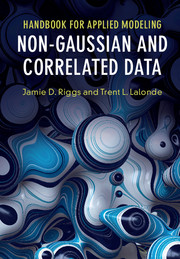Book contents
- Frontmatter
- Dedication
- Contents
- Preface
- 1 The Data Sets
- 2 The Model-Building Process
- 3 Constant Variance Response Models
- 4 Nonconstant Variance Response Models
- 5 Discrete, Categorical Response Models
- 6 Count Response Models
- 7 Time-to-Event Response Models
- 8 Longitudinal Response Models
- 9 Structural Equation Modeling
- 10 Matching Data to Models
- Bibliography
- Index
9 - Structural Equation Modeling
Published online by Cambridge University Press: 03 August 2017
- Frontmatter
- Dedication
- Contents
- Preface
- 1 The Data Sets
- 2 The Model-Building Process
- 3 Constant Variance Response Models
- 4 Nonconstant Variance Response Models
- 5 Discrete, Categorical Response Models
- 6 Count Response Models
- 7 Time-to-Event Response Models
- 8 Longitudinal Response Models
- 9 Structural Equation Modeling
- 10 Matching Data to Models
- Bibliography
- Index
Summary
Introduction
Structural equation modeling (SEM) may be considered as using models of covarying variables. The models systematize variables by type, either manifest (observable and measurable variables) or latent (not directly measurable variables), that depend on the covariance of other manifest or latent variables. This includes the popular regression models of manifest variables dependent on covarying manifest predictor variables. An extension of regression models allows for the analysis of latent variable effects underlying manifest predictor variables that influence a manifest response variable. Latent prediction variables characterizing a response leads to models in which one or more latent variables that influence the covariance behavior of a set of manifest variables. Finally, SEM includes models of latent variables influencing not only manifest variables, but also other latent variables. SEM, then, is a set of models designed to manage a variety of relationships among both observable and unobservable variables.
Prior to utilizing SEM, analysts and researchers must formulate a hypothesis relating the variables of interest. That is, SEM requires subject matter expertise to devise meaningful variable covariance structures. The outcome of SEM analysis is assessments of chosen data set substantiation of the proposed hypotheses. The validity of SEM lies in the unification the analysis and the subject matter.
Intelligence quotient measures, motivation level identification, and ancient craterproducing impactor properties are examples of problems that can be examined with SEM. Each of these examples of latent behavior and resurfacing agents require the quantification of proxy or aftermath observable measurements, and are investigations of proposed or hypothesized relationships among a set of concomitant variables. Intelligence quotients often cannot be measured directly, so other related variables such as quantitative reasoning, reading and writing ability, short- and long-term memory, and visual processing are measured and hypothesized to be the outcomes of levels of intelligence. Purchasing motivation may be hypothesized to be the influencer of internet link paths among websites including the website link sequence and the website dwell time. Scientists hypothesize and have sample evidence that asteroids and comets caused impact craters on the Moon. Variables that can be measured to associate the observed impact crater characteristics with the causal impactor latent unobserved characteristics are the observed orbiting asteroids and comets, existing crater diameters, rim-to-floor depths, and ejecta spatial patterns.
- Type
- Chapter
- Information
- Handbook for Applied Modeling: Non-Gaussian and Correlated Data , pp. 183 - 201Publisher: Cambridge University PressPrint publication year: 2017



